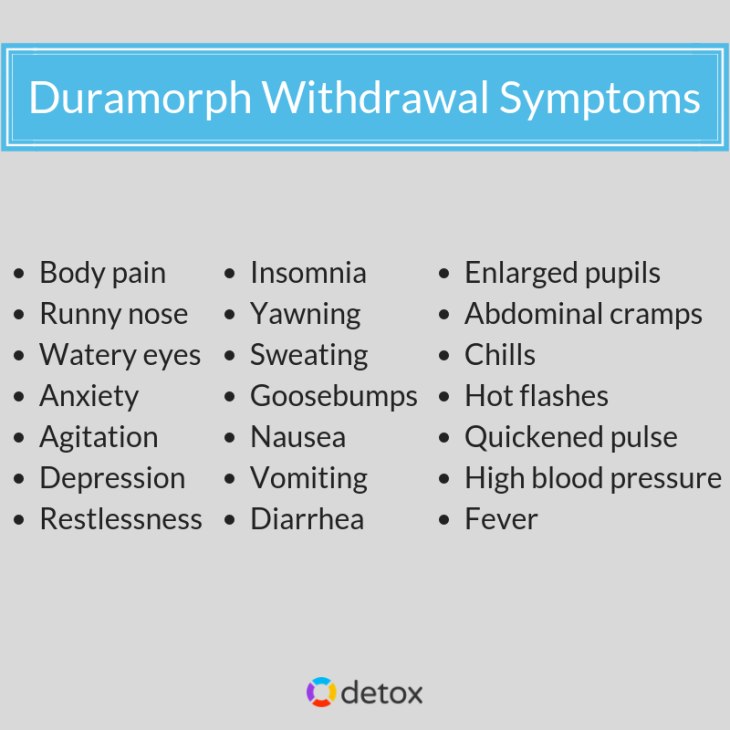Duramorph Detox

Duramorph is the brand name for a morphine injection often given to patients who are going through surgery or are otherwise in severe pain that will not respond to non-narcotic painkillers. Duramorph can be a necessary medication for those with intense pain, but unfortunately, many people also abuse drugs like this one because it can cause euphoria, relaxation, and other desirable effects. If taken for long periods of time regularly—whether abused or taken as prescribed—people can become dependent on Duramorph. The drug can cause an intense withdrawal syndrome when individuals are suddenly taken off it, which is serious and requires Duramorph detox in a professional treatment center.
Call 800-996-6135 now to speak with a treatment advisor and begin your recovery from Duramorph dependence. We can help you find the best detox centers available for your needs as well as answer any questions you may have about opioid dependence, detox, and recovery.
Understanding Duramorph Abuse
Duramorph is available for intravenous, epidural, or intrathecal administration for those experiencing severe pain that cannot be treated with other medications.
While it is effective for those who need intensive painkillers—such as women giving birth—doctors must be very careful when prescribing Duramorph.
- Morphine is the most commonly cited prototype for opioid drugs that pose a threat of addiction. Some people are able to get ahold of it by doctor shopping while others may purchase it illegally.
- Duramorph is especially vulnerable because it is already available in its most potent state (injection).
- People who abuse drugs like Duramorph can quickly become addicted as well as tolerant and dependent.
The opioid crisis in the United States is at its most severe in years, and many people abuse drugs like these in order to stave off withdrawal from a general dependence on opioids. Anyone struggling with opioid addiction will need professional help in a rehab center.
Duramorph Abuse and Dependence
Duramorph abuse can cause a person to become dependent. However, even someone who receives the drug as prescribed for a long enough period of time can become dependent on it, and this can happen rather quickly, as morphine is so much more powerful than most opioids.
A person is dependent on a drug when they can no longer feel normal without it. This may cause them to require the drug just to go to sleep at night or to feel like themselves. Though it is a common occurrence with long-term treatment, it is also dangerous, as dependence can lead to abuse (if it hasn’t already).
Duramorph Withdrawal
When a person becomes dependent on Duramorph, withdrawal can occur if the individual suddenly stops taking the drug. Withdrawal is a syndrome that causes the individual to experience intense symptoms because their brain and body need to recover and adjust to no longer receiving access to the drug (National Library of Medicine). Opioid-based withdrawal isn’t usually life-threatening if it is uncomplicated, but it can still be extremely uncomfortable, even unbearable for some.
Signs and Symptoms of Duramorph Withdrawal

Duramorph withdrawal is basically like other types of opioid withdrawal. For the most part, the syndrome feels similar to the flu, but the individual will also be hit with bouts of pain and discomfort that range from mild to severe. The individual’s tolerance for pain will be extremely low at this point because their body has relied on Duramorph to mask it for so long, they have become dependent on this effect.
The common signs and symptoms of Duramorph withdrawal include
- Muscle, bone, and joint pain
- Runny nose
- Watery eyes
- Anxiety
- Agitation
- Depression
- Restlessness
- Insomnia
- Yawning
- Sweating
- Goosebumps
- Nausea
- Vomiting
- Diarrhea
- Enlarged pupils
- Abdominal cramps
- Chills
- Hot flashes
- Quickened pulse
- High blood pressure
- Fever
Usually, this syndrome is manageable, and detox centers can offer patients safe, effective treatments that will make the symptoms less intense. However, there are times where the syndrome itself becomes complicated, and the patient can experience severe, potentially even life-threatening effects.
Timeline of Duramorph Withdrawal
According to the NLM, morphine injections are short-acting, so most individuals who become dependent on Duramorph will begin experiencing withdrawal symptoms at least 8 hours or so after their last dose. The first 24 hours are usually the most uncomfortable, but pain and discomfort can stretch into the entire syndrome of withdrawal and even into the post-acute withdrawal syndrome or PAWS.
- Day 1-3: Most individuals experience pain, discomfort, and the flu-like symptoms associated with withdrawal. They will feel miserable, and it will be difficult for them to engage in their daily activities. As such, it is usually best if they just rest.
- Day 4-7: This stage often sees the beginning of symptoms like diarrhea, vomiting, and abdominal cramps. Pain and flu-like symptoms could continue into this stage of withdrawal as well.
- Day 8-15: At this point, withdrawal symptoms start to diminish. It can be difficult to know for certain if the process is really over, however, so those going through it must be careful not to stop treatment and try to get back to their normal lives too early.
PAWS usually occurs for several weeks after withdrawal ends. This syndrome is associated with long-term phantom pain, insomnia, anxiety, and depression. Some individuals may also have trouble focusing on specific tasks for a few weeks afterward.
Dangers of Duramorph Withdrawal
Opioid withdrawal is often considered to be mild if uncomplicated, but this is why many people make the mistake of going through it at home. Without the proper treatment, if it does become complicated, your Duramorph withdrawal could be severely dangerous and possibly even life-threatening.
Those who do not ingest enough liquids during withdrawal leave themselves vulnerable to dehydration. The vomiting, diarrhea, and sweating experienced during the syndrome can make an individual dangerously dehydrated, and this can become a medical issue if fluids are replenished.
Depression is a serious symptom of Duramorph withdrawal that, if untreated, can become much worse. Doctors are urged to screen for depression any time a patient comes to them with opioid dependence, and those who are not treated properly for these symptoms could experience suicidal thoughts, among other dangerous outcomes.
Relapse is always a threat to those going through withdrawal but especially to those in Duramorph detox. Opioid users who return to drug abuse during or after withdrawal are more likely to overdose than at any other time.
Opioid overdose is extremely dangerous and can cause symptoms like
- Slow breathing
- Shallow breathing
- No breathing
- Unconsciousness
- Fainting
- Blurry vision
- Slowed heartbeat
- Nausea
- Coma
- Brain damage
- Death
Avoiding all of these complications should always come into play during Duramorph detox, and those who go through the process without the proper treatment might not know how. Though this withdrawal syndrome isn’t considered to be one of the most dangerous, it can become severe if not treated properly.
Am I Dependent on Duramorph?
If you have been using Duramorph for more than a few weeks, you are probably already dependent. This can be the case whether you were abusing the drug or not. Most people do not understand that using Duramorph for a long enough period of time will usually end in dependence, no matter what the reason for your use.
Most doctors do not want patients to become dependent on drugs like Duramorph so they don’t administer it enough to cause this. However, if you are worried you are dependent, it is likely you are.
Should I Go through Duramorph Withdrawal at Home?
There are many different reasons why you should not attempt to go through Duramorph withdrawal at home and without the proper treatment.
- SAMHSA states that opioid withdrawal without medication is unsafe and even produces unnecessary suffering in a population that has a low tolerance for pain.
- Those who try to taper their medications themselves are in danger of taking too much or too little, which could lead to overdose, relapse, extreme pain, and other issues.
- If you are not treated properly, it can be difficult to determine if your withdrawal is becoming complicated based on your depressive symptoms, your level of hydration, etc.
You may want to choose outpatient detox in order to stay at home every night, or inpatient care may be the best fit for you. Whatever you choose, make sure you seek the proper treatment and don’t try to go it alone.
Contact Detox.com now to find Duramorph detox centers near you!
Duramorph Detox Treatment
Duramorph detox usually starts with the medical staff assessing the severity of your dependence with a scale called COWS (clinical opioid withdrawal scale). The scale tells them how dangerous your withdrawal symptoms are and which treatments would be best for your needs. Afterwards, you will usually be put on one of three medications.
Clonidine, an antihypertensive
Clonidine can treat muscle and bone pain, depression, anxiety, and the flu-like symptoms of withdrawal.
Methadone, an opioid agonist
Methadone can treat all the symptoms of withdrawal, including cravings. This is because, when dosed correctly, it blocks the opioid receptors in the brain without causing euphoria.
Buprenorphine, a partial opioid agonist
Buprenorphine works similarly to methadone, but it is safer in abuse situations. Both medications can also be continued after the stabilization period as maintenance drugs (SAMHSA).
Each of these medications has its benefits, and different patients may require a different option. For example, if you have a severe dependence, methadone might be the best choice, but if you were taking the medication as prescribed, clonidine could be effective. You may also receive access to behavioral therapies to prepare you for rehab.
What Happens After Detox?
You absolutely must attend rehab after detox has ended. This is because detox only treats dependence, and if you were abusing Duramorph and/or other drugs like it, you will need treatment for your addiction as well. Otherwise, you will be extremely vulnerable to relapse after detox ends.
Many people choose to attend aftercare programs once rehab has ended or additional treatment programs. As the National Institute on Drug Abuse states, addiction is a long-term, chronically relapsing disease that requires multiple treatment stints in most cases. However, most people start with detox so they can put their abuse of this dangerous drug behind them.
Get Help Today
Finding the help you need for Duramorph abuse and dependence is possible. We are always available to take your call and assist you in finding the best detox programs near you. Call 800-996-6135 to speak with a treatment advisor today.
Sources
- Federal Drug Administration. (2005). Duramorph (Morphine Sulfate Injection, USP).
- U.S. National Library of Medicine. (2016). Opiate and Opioid Withdrawal.
- U.S. National Library of Medicine. (2018). Morphine Injection.
- Substance Abuse and Mental Health Services Administration. (2018). Treatment for Substance Use Disorders.
- Substance Abuse and Mental Health Services Administration. (2016). Buprenorphine.
- National Institute on Drug Abuse. (2018). Treatment Approaches for Drug Addiction.

